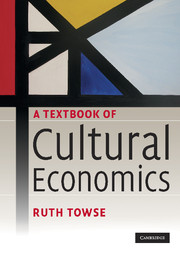Book contents
- Frontmatter
- Contents
- List of figures
- List of tables
- List of boxes
- List of abbreviations
- Preface
- Part I General issues in cultural economics
- Part II The ‘traditional’ economics of the arts and heritage
- Introduction
- 8 Economics of the performing arts
- 9 Economics of cultural heritage
- 10 Economic evaluation of cultural policy
- Part III Artists' labour markets and copyright
- Part IV The creative industries
- Part V Conclusion and exercises and problems
- References
- Index
9 - Economics of cultural heritage
- Frontmatter
- Contents
- List of figures
- List of tables
- List of boxes
- List of abbreviations
- Preface
- Part I General issues in cultural economics
- Part II The ‘traditional’ economics of the arts and heritage
- Introduction
- 8 Economics of the performing arts
- 9 Economics of cultural heritage
- 10 Economic evaluation of cultural policy
- Part III Artists' labour markets and copyright
- Part IV The creative industries
- Part V Conclusion and exercises and problems
- References
- Index
Summary
‘Cultural heritage’ is a very broad term that covers archaeology, artefacts, buildings ancient and modern, museums, archives, works of art, and the like; besides man-made items, heritage also includes intangibles, such as inherited traditions, knowledge and skills, and the natural heritage. Cultural economics has so far mostly applied its analysis to museums and the built heritage; the principles are relevant to all aspects of heritage, however, and, indeed, cultural economists share much the same approach to built heritage as environmental economists do to natural heritage.
Heritage and public goods
What cultural heritage goods and services have in common is that they create a sense of national identity, encourage respect for other cultures and for cultural diversity, foster an understanding of the past and teach aesthetic values. These cultural values of heritage are distinguished from the asset value of heritage capital – the value of the land and buildings occupied by heritage sites, monuments and buildings and the items in museum's collections, and so on – that, at least in principle, could be realised on the market. Outdoor built and natural heritage are often true public goods, in the sense that they are mostly non-excludable and, unless there is congestion, non-rival; in general, it may be too costly to fence them off to exclude users, making charging for entry uneconomic.
- Type
- Chapter
- Information
- A Textbook of Cultural Economics , pp. 237 - 262Publisher: Cambridge University PressPrint publication year: 2010



